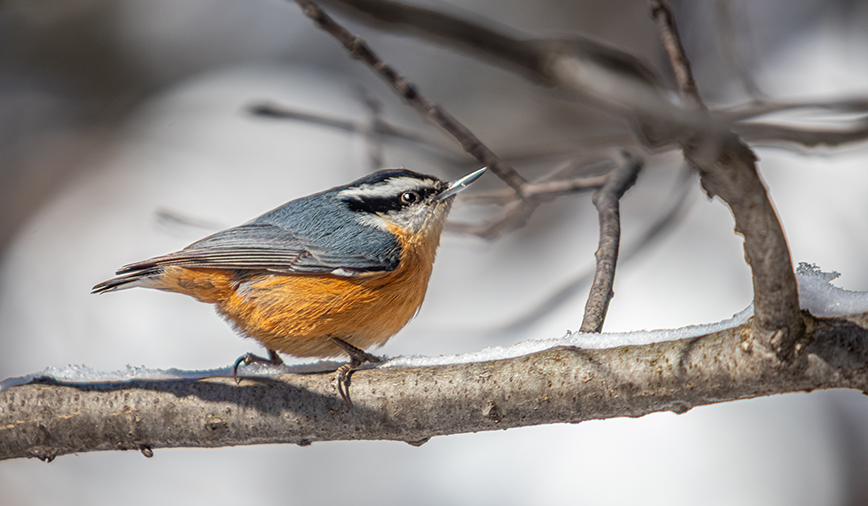I don’t know if you noticed or not, but we’re in the middle of an irruption.
Not an eruption as in,”Kaboom!” Nor an interruption as in, “Psst…” or “Ahem.” But an irruption, as in the ecology term meaning a sudden increase in a species’ population—in this case, red-breasted nuthatches, Sitta canadensis.
I wish I could say it was my keen powers of observation and steadfast connections with our natural world that first clued me in to this fascinating phenomenon.
But, no, that would be wrong.
To give credit where credit is due, I have to tip my hat to none other than…Jimmy. My cat.
A few weeks ago the inveterate observer was perched on the back of his favorite chair, peering out at all his flittering, fluttering friends in the overgrown cedar tree just outside the window. Each time a bird swept close, Jim would launch into his version of that cat thing—you know, where their teeth chatter and they make those little mewing sounds. (Cool side note…some research indicates that this behavior may be linked to an instinct to imitate the sounds of the prey.)
At any rate the noise caught my attention and I too started looking, not so much out the window but at Jim. He was so intent on watching the flock of chickadees hopping about that I really wanted to sneak up behind him and shout, “Boo!”
Thankfully I resisted, and soon was glad I did. Because foraging in the branches, along with the chickadees, were a couple of visitors from way Up North. That’s right, those red-breasted nuthatches I mentioned earlier.
Unlike their cousins the white-breasted nuthatches, Sitta carolinensis, which are year-round residents in our area, red-breasted nuthatches visit this region only occasionally, as irruptive migrants.
“Irruptive” means their movements are not predictable in the way those of “regular” migrating birds are. Red-breasted nuthatches may move in large groups, or small ones. They may fly great distances, or short ones. And some years, they might not migrate at all. Such movements likely are tied to available food supplies, but the whole
What we’ve been seeing this year are small groups of red-breasteds—two birds on up to five or six—keeping company with other—sorry, I can’t resist—birds of a feather, namely their cousins the white-breasteds, but also the chickadees Jimmy observed.
Cathy Martens, our faithful volunteer at Hickory Knolls and a resident of Campton Hills, has been seeing red-breasted nuthatches at her birdfeeders for a few months now. They first showed up in August, and have visited regularly ever since. “Usually two at a time, and with chickadees,” she says.
Bob Andrini, president of Kane County Audubon, confirmed that 2016 is an irruptive year for red-breasteds. “Last year we didn’t see any,” he said during a recent phone call. “But they’re definitely here this year. In fact, I’ve got some coming to our water bath right now.”
If you’d like to keep an eye out for red-breasted nuthatches in your own neighborhood, here’s what to look for: Small, active birds with a blue-gray back and rusty-red breast, topped off with a black cap and distinctive black eye stripe on an otherwise white face.
The birds also can be identified by their behavior. Like other members of the Sittadae, or nuthatch family, red-breasted nuthatches move downward, and head first, as they forage on trees and at feeding stations. This habit has led nuthatches of all types (four species occur in North America) to be referred to as “upside down birds.”
While you’re looking, be sure to be listening too. The call of the red-breasted nuthatch is a sort of a nasally “yank” sound, often likened to the toot of a little tin horn. (Special note for December listening: If you’re hearing little tin horns accompanied by little toy drums—and rooty-toot-toots and rummy-tum-tums—you’re probably NOT hearing nuthatches. Have another slice of fruitcake, have another cup of eggnog, and enjoy the sounds of the season. And please don’t drink and drive.)
Should you be outside, and lucky enough to pick up some persistent “yanks,” perhaps mixed in with the scolding “chick-a-dee-dee-dee” of some chickadees, pay close attention.
You won’t hear any kabooms, or pssts. My cat Jimmy won’t be anywhere close by. (He’s indoors only.) But make no mistake. You’ve found yourself an irruption.
Pam Otto is the manager of nature programs and interpretive services at the Hickory Knolls Discovery Center, a facility of the St. Charles Park District. She can be reached at 630-513-4346 or potto@stcparks.org.

